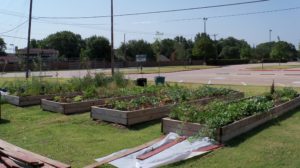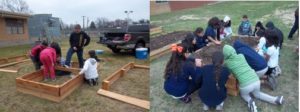By: Jeff Raska, Program Assistant, 4-H Youth Development, Texas A&M AgriLife Extension Dallas County Texas jwraska@ag.tamu.edu
 A school vegetable garden can be a wonderful outdoor classroom for studying natural science or just hanging out writing a story. Having worked on and off with school gardens for 25 years I have seen many great school garden programs bloom and fade as time passes and school priorities change. For the last 7 years, I have had the privilege of working with school gardens as a 4-H Program Assistant for Dallas County and have had the benefit of seeing the wide-ranging needs and challenges that schools face when trying to start a garden. Of the more successful long term programs a few common threads seem to have been in place.
A school vegetable garden can be a wonderful outdoor classroom for studying natural science or just hanging out writing a story. Having worked on and off with school gardens for 25 years I have seen many great school garden programs bloom and fade as time passes and school priorities change. For the last 7 years, I have had the privilege of working with school gardens as a 4-H Program Assistant for Dallas County and have had the benefit of seeing the wide-ranging needs and challenges that schools face when trying to start a garden. Of the more successful long term programs a few common threads seem to have been in place.
One of the first common elements is a dedicated garden committee. The committee can be made up of teachers, parents, community members or school support staff and have certain duties assigned to each member. There needs to be a point person at the school that reaches out for help when needed and maintains accountability. Remember, if funded from outside sources such as grants or corporate sponsors, certain benchmarks must and should be met. The committee needs to determine why to invest the time and resources in a school garden program and how it will benefit their students. I have honestly tried to talk some schools out of pursuing a school garden after it was evident that they didn’t have a committee structure in place for success. The committee should write a list of goals they hope to accomplish and the expected benefits the school garden will bring. They then need to balance those benefits with the costs involved (start up and yearly maintenance), the time it will take out someone’s daily school duties, the team it will take to schedule and carry out a garden program and how they will incorporate the garden into the school’s lesson plans. The committee can be responsible for startup funding, long-term maintenance costs as well as material procurement and maintenance schedules. The committee should research and recommend a school garden curriculum that best fits the schools lesson plans and goals. I recommend the Learn Grow Eat Go Curriculum developed by the Texas A&M AgriLife Junior Master Gardener team through a USDA research grant that not only incorporates the horticultural aspects but also teaches nutrition, cooking and a classroom exercise plan for a complete healthy living model. I incorporate a nutrition element in all school programs I teach (being primarily Title 1 schools) because nutrition is such needed education for communities of need.
The people that make up the committee will change as the year’s pass (kids and parents move up, teachers move schools, Principals change) so a good foundation (Committee) needs to be established and put in place to keep the garden blooming for years to come. I never use the word sustainable in horticultural systems as no natural eco system just sustains itself. In the same way that an ecosystem evolves to climatic changes, understand that school garden programs must also plan to evolve to be able to enjoy long-term success.
3rd Graders building and planting vegetable gardens in Dallas Texas
Related article: Seeds for a healthier future: Mesquite ISD students create, learn in campus garden
Once upon a time, Jeff worked as an IPM coordinator for a local Dallas County school district and began pursuing is love of gardening and youth with AgriLife Extension. Remember we have County Agents in all 254 counties in Texas that can help your school with building and maintaining a youth garden.


 .
.